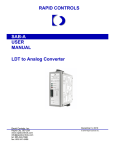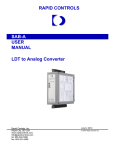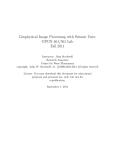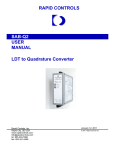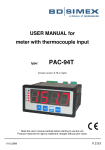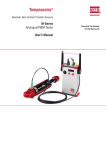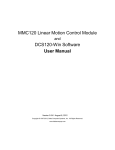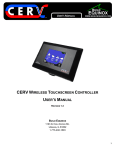Download SAB-A USER MANUAL RAPID CONTROLS LDT to Analog Converter
Transcript
RAPID CONTROLS SAB-A USER MANUAL LDT to Analog Converter Rapid Controls, Inc. Rapid City, SD USA www.rapidcontrols.com [email protected] tel: 605-348-7688 fax: 605-341-5496 December 21, 2011 © 2011 Rapid Controls Inc. 1 Contents 1 Introduction 1.1 Description 1.2 Features 1.3 Models and Ordering Information 2 2 Installation 2.1 Connections 4 3 Configuration 3.1 Jumpers and DIP Switches 3.2 Setup Menu 6 4 General Operation 4.1 Startup 4.2 Sensor Processing 4.3 Status 12 2 Introduction 1 Introduction 1.1 Description The SAB-A converts two channels of magnetostrictive transducer position and velocity to two or four analog voltage outputs. To achieve accurate, low-latency output, the conversion is implemented using a micro-controller, EPLD, and 16-bit digital to analog converters. The SAB-A continually interrogates the sensors for position data at a configurable rate. Immediately after each position update, velocity data is calculated from the collected position data. The analog outputs are then set based on the most recent data available. Sensor update rate, velocity window size, and analog output scaling and offseting are configurable using a text-based menu accessible via an RS-232 serial port. Status LEDs provide visual confirmation of proper sensor operation. A Sensor OK output for each channel allows an external device to monitor sensor interface status. Although the SAB-A was designed for use with magnetostrictive linear displacement transducers, it can be used with other types of sensors such as glass scales or encoders. To be used with the SAB-A, a sensor must be compatible with the one of the sensor protocols supported by the SAB-A: SSI, Start/Stop, or PWM. 1.2 Features • • • • • • • • • • • • Two channels of position from Start/Stop, PWM or SSI magnetostrictive transducers 16-bit analog outputs (0.3 mV resolution) with selectable output voltage range Voltage range options: -10 to 10V, 0 to 10V, -5 to 5V, 0 to 5V Supports arbitrary SSI sensor resolution 56 MHz oscillator provides 0.002 inch resolution without reciculation for Start/Stop or PWM sensors (Internal recirculations may be used to increase this) Allows controlling all analog outputs from a single sensor with different scaling Transducer OK output and LED signals valid transducer operation Software selectable update rate, velocity window, and analog position/velocity scaling and offsetting Setup via RS-232 serial interface Blinking LED indicates good operation of SAB-A Watchdog timer for reset upon software failure Non-volatile memory for storage of setup parameters Introduction 3 • • Convenient screw terminal connections 4.64 × 5.31 × 1.77 (D×H×W) inch DIN rail mount enclosure 1.3 Models and Ordering Information Table 1.1 shows the available SAB-A models. SAB-A units are available with 2 or 4 analog outputs and with support for SSI or Start/Stop and PWM sensors. Model Number Channels Sensor Interface Position Output Velocity Output SAB-A-RPM-PA 2 Start/Stop & PWM 2× 16-bit --- SAB-A-RPM-VA 2 Start/Stop & PWM --- 2× 16-bit SAB-A-RPM-PA-VA 2 Start/Stop & PWM 2× 16-bit 2× 16-bit SAB-A-SSI-PA 2 SSI 2× 16-bit --- SAB-A-SSI-VA 2 SSI --- 2× 16-bit SAB-A-SSI-PA-VA 2 SSI 2× 16-bit 2× 16-bit Table 1.1 SAB-A Models and Ordering Information 4 Installation 2 Installation 2.1 Connections The connectors of the SAB-A are shown in Figure 2.1. A diagram of thes connectors is shown in Figure 2.2. Finally, Table 2.1] shows the pinout of the connectors. Figure 2.1 SAB-A Connector Locations Figure 2.2 SAB-A Connector Placement Installation 5 Pin Function Pin Function J1-1 Logic Ground J3-1 Ch A Clock+ to Sensor J1-2 RS-232 RX from Host J3-2 Ch A Clock− to Sensor J1-3 RS-232 TX to Host J3-3 Ch A Data+ from Sensor J1-4 Reserved J3-4 Ch A Data− from Sensor J1-5 Reserved J3-5 +24VDC Power to Sensor J1-6 Input 1 J3-6 Ground J1-7 Input 2 J3-7 No Connect J1-8 Input Common J3-8 Ch B Clock+ to Sensor J1-9 Ch0 Sensor Status Output J3-9 Ch B Clock− to Sensor J1-10 Ch1 Sensor Status Output J3-10 Ch B Data+ from Sensor J3-11 Ch B Data− from Sensor J4-1 +24 or +15VDC Power J3-12 +24 or +15VDC Power to Sensor J4-2 Power common and signal ground J3-13 Ground J4-3 -15VDC Power (Optional) J3-14 -15VDC Power to Sensor (if needed) Analog J1-1 (Pos) Ch A Position Analog Out Analog J1-1 (Vel) Ch A Velocity Analog Out Analog J1-2 (Pos) Analog Ground Analog J1-2 (Vel) Analog Ground Analog J1-3 (Pos) Ch B Position Analog Out Analog J1-3 (Vel) Ch B Velocity Analog Out Table 2.1 SAB-A Connector Pinouts Configuration 6 3 Configuration 3.1 Jumpers and DIP Switches 3.1.1 DIP Switch S1 Dip switch S1 is used to select the desired analog output voltage range for all of the analog output channels. The voltage range can be configured to operate with one of these output ranges: -10 to 10 V, 0 to 10V, -5 to 5V, and 0 to 5V. The SAB-A’s analog outputs will maintain 16-bit resolution in any of the voltage output ranges. Switch Description Switch Off Switch On Bipolar Unipolar 10V 5V S1-1 Analog voltage bipolar/unipolar range select S1-2 Analog voltage 10V/5V range select S1-3 Unused --- --- S1-4 Unused --- --- S1-5 Unused --- --- S1-6 Unused --- --- S1-7 Unused --- --- S1-8 Unused --- --- Table 3.1 Dip Switch S1 Settings For example, to configure the analog outputs to be 0 to 10V, set switch S1-1 On (unipolar mode) and switch S1-2 Off (10V). 3.1.2 Jumper X2 Jumper X2 sets the output mode of the sensor status outputs, sinking or sourcing. The status outputs must be configured to match the common applied to J1-8. If ground is applied to J1-8 the outputs must be sinking. If a voltage (+12 to +24 VDC) is applied to J1-8 the outputs will source the voltage. Configuration 7 Shunt Placement Output Mode J1-8 Connection 1-3, 5-7, 2-4 & 6-8 Sinking Ground 1-2, 3-4, 5-6 & 7-8 Sourcing +12 to +24 VDC Table 3.2 Jumper X2 Settings 3.2 Setup Menu Configuration of the SAB-A is accomplished through an interactive setup menu. The setup items accessable in this menu are stored in non-volatile memory. The setup menu can be accessed via an RS-232 serial connection using a computer or other terminal device connected to the J1 connector. The connection should be established using the parameters shown in Table 3.3. To access the setup menu, transmit three escape (ASCII 27) characters rapidly. The SAB-A will display a setup menu and prompt for further input. The setup menu will display a list of parameters and values. Each of these parameters may be changed by transmitting the letter shown next to the parameter. In addition to the setup parameters, the menu shows the position most recently gathered from the sensors. After changes have been made, the changed parameters must be committed to non-volatile memory or they will be lost when power is removed from the SAB-A. Choose Save to EEPROM to save all parameters to non-volatile memory. To exit the setup menu and return to normal operation, choose Quit from the menu (transmit the letter ’Q’) or cycle power to the SAB-A. Parameter Configuration Baud Rate 9600 bps Data Bits 8 Parity None Stop Bits 1 Handshaking Table 3.3 None Serial Parameters 3.2.1 Default Configuration A set of default parameters (see Table 3.4) are stored in the SAB-A when it leaves the factory. The default parameters can be restored by selecting the Factory Defaults option from the setup menu. 8 Setup Item Default Value Detected Update Time N/A Transducer Update Time 2 ms Eavesdrop Mode Normal Transducer Type 24-bit SSI SSI Protocol Binary Analog Position Start 0 counts Analog Position Range 100000 counts Analog Velocity Range 100000 counts/s Velocity Output Type Velocity Velocity Window Size 50 transducer update periods Table 3.4 Configuration SAB-A Default Configuration 3.2.2 Configuration Parameters 3.2.2.1 Eavesdrop Mode Eavesdropping mode allows the SAB-A to monitor data from a sensor that an external device is interrogating. When eavesdrop mode is enabled, the SAB-A monitors the communication between the external devices and the sensor to collect sensor data. The sensor update period is automatically detected. Eavesdrop mode can be set to one of two modes: Normal or Eavesdrop. In normal mode, the sensor is interrogated by the SAB-A. In eavesdrop mode, the sensor is interrogated by an external device. 3.2.2.2 Detected Update Time The detected update time is a read-only value that is only valid when operating in eavesdrop mode (see 3.2.2.1.) The update time is detected by monitoring the interrogate pulses received from the external device that is interrogating the sensor. When operating in normal, non-eavesdrop mode, this value should be ignored; the update period can be set by changing the Transducer Update Time setup item. 3.2.2.3 Transducer Type The transducer type selects the protocol used to communicate with the attached sensor. Available options are SSI 24, SSI 25, Start/Stop, PWM, and Copy Other. The SSI options indicate the Configuration 9 number of bits returned by the transducer and should be used with SAB-A-SSI models. The Start/Stop and PWM settings are to be used with SAB-A-RPM models. The Copy Other option is a special option that causes the selected channel to use the position information from the other channel. This mode is designed for operation with a single sensor. Although the position information is copied from the other channel, the setup items may differ between the channels. For example, the 2 nd channel could have a different velocity window size or a different analog range. Menu Selection Required Model Sensor Protocol Notes SSI 24 SAB-A-SSI-* SSI 24-bit data word SSI 25 SAB-A-SSI-* SSI 25-bit data word Start/Stop SAB-A-RPM-* Start/Stop PWM SAB-A-RPM-* PWM Copy Other Any None Table 3.5 Data copied from other channel Transducer Type Settings 3.2.2.4 SSI Protocol SSI sensors are available with two coding schemes: binary and graycode. The SAB-A supports either scheme. Set the SSI Protocol to Binary for binary-output SSI sensors and Graycode for graycode-output SSI sensors. If the wrong coding scheme is selected, position data will appear to jump around instead of changing smoothly. 3.2.2.5 Transducer Update Time The transducer update time is the number of milliseconds between each update of the transducer position information. When using a magnetostrictive transducer, the update time must be long enough to allow the strain pulse to travel the length of the wand. The wavespeed of a typical magnetostrictive transducer is 9 µs / inch. If a sensor with internal recirculations are used, multiply the required time by the number of recirculations. If the update time is set to a value that does not allow for propogation of the strain pulse, the position data will be unstable. See Table 3.6 for a list of possible update time settings. If the sensor used is not a magnetostrictive transducer, configure the update time as instructed by the manufacturer of the sensor. Configuration 10 Sensor Length (in) Recirculations Update Time (ms) 1 - 100 1 1 101 - 200 1 2 201 - 300 1 3 301 - 400 1 4 1 - 50 2 1 51 - 100 2 2 101 - 150 2 3 200 - 201 2 4 1 - 25 4 1 26 - 50 4 2 51 - 75 4 3 76 - 100 4 4 Table 3.6 Suggested Update Times 3.2.2.6 Velocity Window Size The velocity window size determines how many historical position updates are included in the calculation of the velocity output. For example, if the velocity window size is 10, the current position and the position 10 transducer updates ago are used to calculate the velocity. 3.2.2.7 Analog Position Start The analog position start is the number of counts which corresponds to the minimum analog output value (−10V, −5V, or 0V DC.) Any position less than the analog position start will be output as the minimum analog output value. 3.2.2.8 Analog Position Range The analog position range parameter sets the number of counts covered by the total range of the analog position output. For example, if the analog output voltage range is -10 to 10V, analog position start is 5000 and analog position range is 25000, output will be -10V at 5000 or less counts, 0V at 17500 counts, and 10V at 30000 counts and higher. 3.2.2.9 Analog Velocity Range The analog velocity range parameter sets the number of counts/sec covered by each half of the analog velocity output. For example, if the analog output voltage range is -10 to 10V and the 11 Configuration analog velocity range is 20000, the output will be -10V at -20000 counts/sec, 0V at 0 counts/sec, and 10V at 20000 counts/sec. 0V is always output when the speed is 0 counts/second. 3.2.2.10 Velocity Output Type The analog velocity output type parameter controls the style of the velocity analog outputs. One of two options may be selected: velocity or speed. When speed is selected, the absolute value of the velocity is output. When speed is selected, a speed of zero is output as the lowest possible analog output voltage; when velocity is selected, a velocity of zero is output at the center of the voltage range. 3.2.2.11 Save to EEPROM Select this item to save the values to non-volatile memory. Any configuration items changed will not be saved until this is selected. 3.2.2.12 Load from EEPROM Select this item to load the values from the non-volatile memory. This will revert any changes made since the last time values were saved to non-volatile memory. 3.2.2.13 Factory Defaults Select this item to change all of the setup values to the factory defaults, as shown in Table 3.4. Defaults are not saved to non-volatile memory until the Save to EEPROM menu item is selected. 3.2.2.14 Quit Select this item to exit setup and return to normal operation. The configuration values entered via the setup menu will be in effect at this point. Any values not saved to the EEPROM will be lost when power is removed. General Operation 12 4 General Operation 4.1 Startup At power-on, the board will print a sign-on message indicating the date of software in the board and the status of the retrieval of data stored in the non-volatile EEPROM. A message similar to the following is displayed: Rapid Controls Inc. SAB-A Copyright(c) 1997-2010 Rapid Controls Inc. 03-01-2010 EEPROM load successful. 4.2 Sensor Processing The SAB-A interfaces with two magnetostrictive transducers and interrogates the sensors for position information at a user-defined rate. After valid sensor data is received on a sensor interface channel, the data is processed as shown in Figure 4.1. Position data history over a user defined window is stored for use in velocity calculation. Scaling and offsetting is performed on the position and velocity data before output via 16-bit DAC. Position History Sensor Interface Position Data Velocity Processing Velocity Scaling Velocity Analog Output Position Scaling Position Analog Output Figure 4.1 Sensor Data Processing for One Channel 4.2.1 Sensor Interface Each sensor interface is capable of interfacing with sensors supporting three protocols commonly used with magnetostrictive transducers: SSI, Start/Stop and Pulse-Width Modulated (PWM). Other types of sensors, such as absolute encoders, laser rangefinders, and glass scales support the SSI protocol and are compatible with the SAB-A. 13 General Operation SAB-A-SSI models support SSI protocol sensors. SAB-A-RPM models support Start/Stop and PWM protocol sensors. Each sensor interface can operate in one of two modes: normal mode and eavesdropping mode. In normal mode, the sensor is interrogated at a fixed update rate. In eavesdropping mode, an external master device must interrogate the sensor. The SAB-A monitors the communications between the external master and the sensor. Position data is stored each time the sensor is interrogated. 4.2.2 Velocity Calculation After position data is received, the data is stored in a circular queue. This queue holds a configurable amount of historical position data. Each time new position data is received, this position data, along with the historical position data, is used to calculate a velocity value. V = P0 − P−n n × TS (4.1) Equation 4.1 shows the calculation used to determine velocity. V is the velocity in units per second. n is the windows size. P0 is the current position, P−n is the oldest position information in the window. TS is the sensor update period in seconds. 4.2.3 Scaling and Output After sensor data is received and velocity data is calculated, the data is scaled and offset. The configuration parameters Analog Position Start, Analog Position Range, and Analog Velocity Range are used to control this process. 4.3 Status A red LED on the board blinks during operation. Two green LEDs indicate the status of the transducers. A lit LED indicates a good transducer, and a dim or dark LED indicates a missing or failing transducer or magnet. Sensor status may also be read via the digital outputs. See Section 3.1.2 for information on configuring the digital outputs for sinking or sourcing operation.














